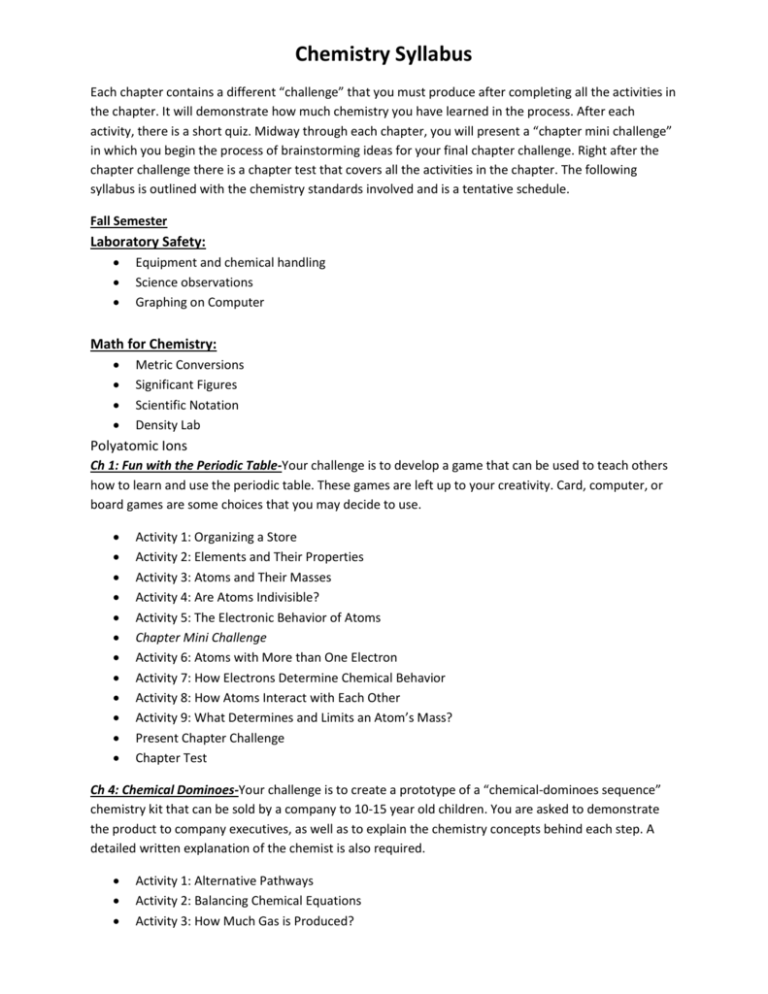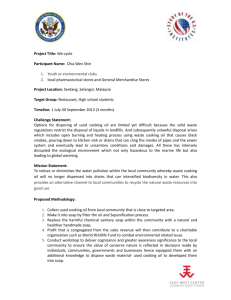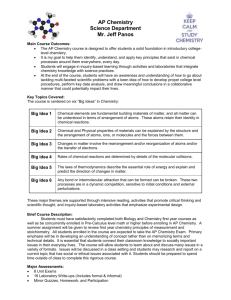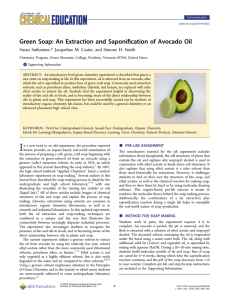Chemistry Syllabus
advertisement

Chemistry Syllabus Each chapter contains a different “challenge” that you must produce after completing all the activities in the chapter. It will demonstrate how much chemistry you have learned in the process. After each activity, there is a short quiz. Midway through each chapter, you will present a “chapter mini challenge” in which you begin the process of brainstorming ideas for your final chapter challenge. Right after the chapter challenge there is a chapter test that covers all the activities in the chapter. The following syllabus is outlined with the chemistry standards involved and is a tentative schedule. Fall Semester Laboratory Safety: Equipment and chemical handling Science observations Graphing on Computer Math for Chemistry: Metric Conversions Significant Figures Scientific Notation Density Lab Polyatomic Ions Ch 1: Fun with the Periodic Table-Your challenge is to develop a game that can be used to teach others how to learn and use the periodic table. These games are left up to your creativity. Card, computer, or board games are some choices that you may decide to use. Activity 1: Organizing a Store Activity 2: Elements and Their Properties Activity 3: Atoms and Their Masses Activity 4: Are Atoms Indivisible? Activity 5: The Electronic Behavior of Atoms Chapter Mini Challenge Activity 6: Atoms with More than One Electron Activity 7: How Electrons Determine Chemical Behavior Activity 8: How Atoms Interact with Each Other Activity 9: What Determines and Limits an Atom’s Mass? Present Chapter Challenge Chapter Test Ch 4: Chemical Dominoes-Your challenge is to create a prototype of a “chemical-dominoes sequence” chemistry kit that can be sold by a company to 10-15 year old children. You are asked to demonstrate the product to company executives, as well as to explain the chemistry concepts behind each step. A detailed written explanation of the chemist is also required. Activity 1: Alternative Pathways Activity 2: Balancing Chemical Equations Activity 3: How Much Gas is Produced? Activity 4: What Can Destroy a Metal? Chapter Mini Challenge Activity 5: Producing and Harnessing Light Activity 6: Electrochemical Cells Activity 7: Reactions that Produce Heat Activity 8: Rubber Bands and Spontaneity Ch 11: H2Woes (will be included with chapter 4) Activity 2: Factors Affecting Solubility of Solids Chapter Challenge Chapter Test **FALL FINAL** Spring Semester Ch 5: Ideal Toy- Your challenge is to create a toy that uses various chemical and/or gas principles. Your toy should appeal to an age group of your choice. Your final presentation to the board of the Ideal Toy Company will include a written proposal, either a detailed drawing or a mock prototype of the toy, a statement of any potential hazards or waste disposal issues, and a cost analysis of the item for manufacturing. An oral and written explanation of the chemistry principles used is a key part of the proposal. Activity 1: Batteries Activity 2: Solid, Liquid, or Gas? Activity 3: Cartesian Divers Activity 4: Hot-Air Balloons Chapter Mini Challenge Activity 5: How are Gases Produced? Activity 6: Ideal Gas Law for the Ideal Toy Activity 7: Moving Molecules Activity 8: Plastics Chapter Challenge Chapter Test Ch 7: Cookin’ Chem- Your challenge is to create a segment of a television cooking show that explains in detail the chemistry behind the cooking involved. This can be videotaped, live, or a voice-over of a popular television program. In your final presentation, you must discuss the chemical principles in each part of the food preparation that you select. Activity 1: What is Heat? Activity 2: Safety and Types of Fires Activity 3: Cooking Fuels Chapter Mini Challenge Activity 4: Boiling Water Activity 5: Freezing Water Activity 6: How Do You Choose Cookware? Activity 7: How Do Proteins in Foods React? Activity 8: How Does the Home Canning Process Work? Ch 10: Soap Sense- Your challenge is to create a soap from natural sources that are readily available. In working through the activities, you explore variations in the two main ingredients of soap and their effect on the properties of your target soap. At the conclusion, you will prepare two presentations-one for corporate executives of a soap company and a second the marketing department of that company. Activity 1: What Makes a Good Soap? Activity 2: Modeling Molecules Activity 3: How Do You Clean Dirty Laundry Activity 4: How Does Soap Work? Chapter Mini Challenge Activity 5: How Does Chain Length Affect the Properties? Activity 6: Changing the Fat: Does Unsaturation Make a Difference? Activity 7: Soap, Other Bases, and pH Activity 8: Making Soap Functional and Appealing Chapter Challenge Chapter Test Ch 3: Artist as Chemist-You are asked to create a work of art that expresses yourself and to create a museum display around your artwork. The chemistry concepts you use to produce your artwork will be described in a museum placard. Activity 1: What Makes Something Art? Activity 2: Choice of Media for Durability Activity 3: Chemical Behavior of Metals Activity 4: Physical Behavior of Metals Activity 5: Clay Chapter Mini Challenge Activity 6: Paints Activity 7: Dyes Activity 8: How Does Stained Glass Get Its Color? Chapter Challenge Chapter Test **SPRING FINAL**






